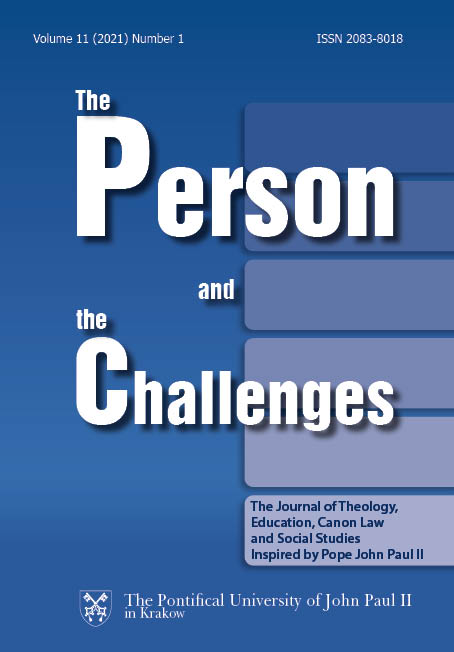Association between one’s attachment to parents and subsequent attachment to a partner
DOI:
https://doi.org/10.15633/pch.3890Słowa kluczowe:
Attachment, child, partner, father, motherAbstrakt
The primary purpose of this study was to explore the association between individuals’ attachments to their mothers and fathers, and their subsequent attachments to partners, based on research conducted in Slovenia. Participants in the empirical study were antenuptial couples who attended the premarital counselling course organized by and offered through the Franciscan Family Institute in Ljubljana, Slovenia. In order to explore more fully the concept of attachment, the authors of the study focused on the following dimensions: trust, communication and estrangement. The results of the study showed greater similarities in the three identified dimensions to the way in which both women and men experience attachment to their mothers and partners, while there were marked differences in the subjects’ experience of attachment to their fathers.
Bibliografia
Armsden G., Greenberg M.,The Inventory of Parent and Peer Attachment: Relationship to well-being in adolescence. Journal of Youth and Adolescence 16 (1987) 5, pp. 427–454.
Belsky J., Fearon R. M., Precursors of attachment security, in: J. Cassidy, P.R.Shaver (eds.), Handbook of attachment: Theory, research and clinical applications, 2008, pp. 295–316.
Blatt S., Blass R., Relatedness and self-definition: A dialectic model of Personality Development, New Jersey 1996: Lawrence Erlbaum Associates.
Bowlby J., Attachment. Attachment and loss, New York 1969: Basic Books.
Bowlby J., Attachment. Attachment and loss. Attachment, 2ed. New York 1982: Basic Books.
Bradshaw J., The Family: A revolutionary way of selfdiscovery, Florida 1988: Health communications inc.
Brajša Žganec A., Emotional Life of the Family: Parental Meta-Emotions, Children’s Temperament and Internalising and Externalising Problems, »Društvena istraživanja« 23 (2014) 1, pp. 25–45.
Cohen J., Statistical Power Analysis for the Behavioral Sciences (2nd Ed) LEA, 1988.
Cvetek R., Predelava disfunkcionalno shranjenih stresnih izkušenj ter metoda desenzitacije in ponovne predelave z očesnim gibanjem, Dissertation, University of Ljubljana, 2004.
Erzar T., Kompan Erzar L.K., Teorija navezanosti, Celje 2011: Celjska Mohorjeva družba.
Field A., Discovering Statistics using IBM SPSS Statistics (4th Ed), London 2013, SAGE.
Gostečnik C., Poskusiva znova, Ljubljana 2001: Brat Frančišek in Frančiškanski družinski inštitut.
Gostečnik C., So res vsega krivi starši?, Ljubljana 2014: Brat Frančišek in Frančiškanski družinski inštitut.
Gostečnik C., Cvetek R., Pate T., Poljak Lukek S., Simonič B., Valenta T., Repič Slavič T., The impact of early aggression on late development, »The Person and the Challenges« 9 (2019) 2, pp. 169–192.
Izard C., On the Development of Emotions and Emotion-Cognitive Relationships in Infancy. The Development of Affect. New York 1978: Plenum Press.
Kompan Erzar L.K., Skrita moč družine, Ljubljana 2003: Brat Frančišek in Frančiškanski družinski inštitut.
Kompan Erzar L.K., Ljubezen umije spomin, Ljubljana 2006: Brat Frančišek in Frančiškanski družinski inštitut.
Kompan Erzar L.K., Erzar T., Teorija navezanosti, Celje 2011: Celjska Mohorjeva družba.
Kuhar M, Jeznik K., Effects of group discussion attachment styles and facilitation on the quality of deliberation, »Društvena istraživanja« 27 (2018) 2, pp. 281–303.
Mikulincer M., Shaver P.R., Attachment in adulthood: Structure, dynamics and change, NY 2010: Guilford Press.
Mitchell S., Relational concepts in Psychoanalysis, Harvard 1988: University Press.
Puhar A., Prvotno besedilo življenja, Studia Humanitatis 2004.
Rothschild B., The body remembers: The psychophysiology of trauma and trauma treatment. New York 2000: WW Norton&Compani.
Rotschild B., The body remembers casebook: Unifing methods and models in the treatment of trauma and PTSD, New York 2003: W.W. Norton&Compani.
Rotschild B., Help for the helper: The psychophysiology of compassion fatigue and vicarious trauma, New York 2006: W.W. Norton&Compani.
Schore A., Affect Disregulation and disorder of the Self, New York Norton 2003: W.W. Norton.
Simonič B., Empathic parenting and child development, »The Person and the Challenges« 5 (2015) 2, pp. 109–121.
Stern D., The interpersonal world of the infant, Camridge 1985: Harvard University press.
Stern D., The present moment in psychotherapy and everyday life, New York 2004: W.W. Norton&Company.
Van der Kolk B., Treating Trauma Survivors with PTSD, Washington, DC 2002: American Psychiatric Press, Inc.
Xie X., Mulej Bratec S., Schmid G., Meng C., Doll A., Wohlschager A., Finke K., Forstl H., Zimmer C., Pekrun R., Schilbach L., Riedl V., Sorg C., How do you make me feel better? Social cognitive emotion regulation and the default mode network, »Neuroimage« 134 (2016), pp. 270–280.
Pobrania
Opublikowane
Numer
Dział
Licencja
Autorzy publikujący w czasopiśmie udzielają jego wydawcy zgody o następującej treści:
- Autor zachowuje autorskie prawa majątkowe do utworu, a jednocześnie udziela wydawcy czasopisma zgody na jego pierwszą publikację w wersji drukowanej i wersji online na licencji Creative Commons Uznanie autorstwa 4.0 Międzynarodowe oraz zgody na wykonywanie opracowań, w tym przekładów.
- Autor ma możliwość udzielania zgody niewyłącznej na opublikowanie utworu w wersji, która ukazała się w czasopiśmie (np. zamieszczenia go w repozytorium instytucjonalnym lub opublikowania w książce), wraz z informacją o jego pierwszej publikacji w czasopiśmie.
- Autor może umieścić swój utwór online (np. w repozytorium instytucjonalnym lub na swojej stronie internetowej) jeszcze przed zgłoszeniem utworu do czasopisma.

